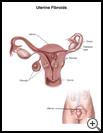
Uterine Fibroid
________________________________________________________________________
KEY POINTS
- A uterine fibroid is a noncancerous growth in the uterus. It grows slowly in or from the wall of the uterus.
- If a fibroid is not causing any symptoms or other problems, it usually does not need treatment. If you need treatment, your provider may suggest medicines to shrink the fibroid, or procedures that block blood flow to the fibroid, or to remove the fibroid or the uterus.
- Follow the full course of treatment prescribed by your healthcare provider. Ask your provider what symptoms or problems you should watch for and what to do if you have them.
________________________________________________________________________
What is a uterine fibroid?
A uterine fibroid is a noncancerous growth in the uterus. It grows slowly in or from the wall of the uterus. The uterus is the muscular organ at the top of the vagina. Babies grow in the uterus, and menstrual blood comes from the uterus. Sometimes fibroids grow in the cervix. The cervix is the lower part of the uterus that opens into the vagina.
A uterine fibroid may be as small as a pea or as large as a grapefruit. As the fibroid grows, it may change the shape of the uterus or move it out of place. If this happens, it may cause symptoms in your bladder or intestines. In rare cases, a rapidly growing fibroid may become cancerous.
Fibroids are common in women between the ages of 20 and 50. When a woman goes through menopause, the fibroids usually shrink.
What is the cause?
The cause of uterine fibroids is not known. Estrogen and other hormones produced by the ovaries may play a role. Your risk for fibroids may be greater if other women in your family have had them.
What are the symptoms?
Often there are no symptoms. When there are symptoms they may include:
- Painful or heavy menstrual periods
- Needing to urinate more often
- Pain during sex
- Backache
- Constipation
- Pain or pressure in your lower belly
- Trouble getting pregnant
- Miscarriage
How is it diagnosed?
Your healthcare provider will ask about your symptoms and medical history and examine you. Uterine fibroids are usually found during routine pelvic exams. You may have an ultrasound scan, which uses sound waves to see the fibroid, measure the size, and check growth.
How is it treated?
If a fibroid is not causing any symptoms or other problems, it usually does not need treatment.
Your healthcare provider may recommend treatment based on:
- How much pain and blood loss you have during menstrual periods
- If the fibroid is getting bigger and how fast it is growing
- Where the fibroid is
- Whether you are having trouble getting pregnant
- Your age and physical condition
For a fibroid that needs treatment, your provider may suggest:
- Medicine to shrink the fibroid. The medicine can keep your body from making hormones that cause fibroids to grow and cause problems. If you are close to menopause, your healthcare provider may prescribe this medicine for you to take until you are in menopause, and you may not need any other treatment.
- A procedure to block the blood supply to the fibroid. This may help to shrink the fibroids and can help stop heavy bleeding.
- A procedure to remove the fibroid without removing the uterus.
- A procedure to remove your uterus and the fibroids. This may be done if you:
- Have severe symptoms that do not respond to other treatments and do not want to have future children
- Have cancer
- A procedure to scrape or suction tissue from the uterus. This procedure does not remove the fibroid and the abnormal bleeding may come back.
Even if fibroids are removed, you may get more.
How can I take care of myself?
Follow the full course of treatment prescribed by your healthcare provider. In addition:
- Take nonprescription pain medicine, such as acetaminophen, ibuprofen, or naproxen. Read the label and take as directed. Unless recommended by your healthcare provider, you should not take these medicines for more than 10 days.
- Nonsteroidal anti-inflammatory medicines (NSAIDs), such as ibuprofen, naproxen, and aspirin, may cause stomach bleeding and other problems. These risks increase with age. Take these medicines with food whenever possible.
- Acetaminophen may cause liver damage or other problems. Unless recommended by your provider, don't take more than 3000 milligrams (mg) in 24 hours. To make sure you don’t take too much, check other medicines you take to see if they also contain acetaminophen. Ask your provider if you need to avoid drinking alcohol while taking this medicine.
- If you bleed a lot during your periods, you may need more iron. Eat foods high in iron, such meat, poultry, and fish, fruits, vegetables, grains, nuts, eggs, dairy products, and iron-enriched foods. Ask your healthcare provider if you should take iron pills.
- Put warm moist cloths, a hot water bottle, or heating pad on your lower belly. Cover the hot water bottle with a towel or set the heating pad on low so you don’t burn your skin.
- Ask your provider:
- How long it will take to recover
- If there are activities you should avoid and when you can return to your normal activities
- How to take care of yourself at home
- What symptoms or problems you should watch for and what to do if you have them
- Make sure you know when you should come back for a checkup. Keep all appointments for provider visits or tests.

